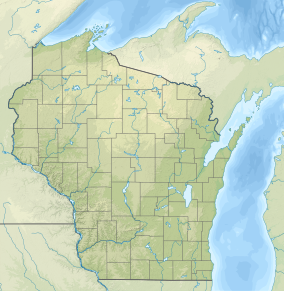Pattison State Park
| Pattison State Park | |
|---|---|
IUCN category V (protected landscape/seascape) | |
 Big Manitou Falls | |
| Location | Douglas, Wisconsin, United States |
| Coordinates | 46°31′36″N 92°07′20″W / 46.52667°N 92.12222°W |
| Area | 1,436 acres (5.81 km2) |
| Established | 1920 |
| Governing body | Wisconsin Department of Natural Resources |
| Website | Pattison State Park |
Pattison State Park is a 1,436-acre (581 ha) Wisconsin state park south of Superior, Wisconsin. Situated on the Black River, the park contains both Big Manitou Falls, the highest waterfall in Wisconsin at 165 feet (50 m), and Little Manitou Falls, which is 30 feet (9.1 m). Pattison State Park was established in 1920.[1]
History[edit]
Pattison State Park is named after Martin Pattison, an early lumber man and miner. In 1879, the company he was working with moved to Superior. After becoming wealthy in the iron mining business, he purchased an entire city block on the harbor, where he built the 42-room Martin Pattison House, which is now the Fairlawn Mansion and Museum. In 1917, there was a plan to build a "power dam" on the Black River. The dam would have destroyed what is known as the Big Manitou Falls. Pattison took the initiative to save the falls by secretly buying land, 660 acres (270 ha) in total from different land owners along the river. In 1918, he donated the land to the state which led to Wisconsin dedicating its sixth state park to Martin Pattison on January 20, 1920. Until 1935, Pattison State Park consisted of a small picnic area, some wooden overlooks, pit toilets, and a ranger cabin. On July 25, 1935, the Civilian Conservation Corps (CCC) began renewing the park. The Corps quarried rock and chiseled it into blocks to create the park shelter building, nature center, bathhouse, and former office building. It also drained Interfalls Lake, rerouted the river channel, hauled sand from Lake Superior's shore to make the beach, installed sewer and water systems, removed old roadbeds, planted trees, and landscaped and built three miles of foot trails.[2]
Activities and amenities[edit]
- Nature center: The Gitche Gumee Nature Center features exhibits about the park's cultural and natural history, including its wildlife and geology.[3] Guided nature walks are offered, and children's nature exploration backpacks are also available.
- Swimming: The park has a 300-foot (91 m) sand beach on Interfalls Lake.[4]
- Trails: The park's 9 miles (14 km) of hiking trails include trails that are used for cross-country skiing and snowshoeing. Beaver Slide Nature Trail is 2 miles long and circles Interfalls Lake. Logging Camp Trail is 4.7 miles long from which some of the remains of Pattison's old logging camp by the Black River, can be seen.[2]
- Camping: The park has 59 family campsites, 18 of them with electric hookups, and 3 backpack sites.[2]
References[edit]
- ^ "History". Pattison State Park. Wisconsin DNR. July 3, 2013. Retrieved September 4, 2013.
- ^ a b c "Pattison State Park". State Parks. Retrieved November 24, 2014.
- ^ Smith, John (n.d.). "Camping in Pattison State Park in Wisconsin". Travel Tips. USA Today. Retrieved September 4, 2013.
- ^ "Activities and recreation". Pattison State Park. Wisconsin DNR. January 18, 2013. Retrieved September 4, 2013.
External links[edit]
![]() Media related to Pattison State Park at Wikimedia Commons
Media related to Pattison State Park at Wikimedia Commons
- Pattison State Park Wisconsin Department of Natural Resources


